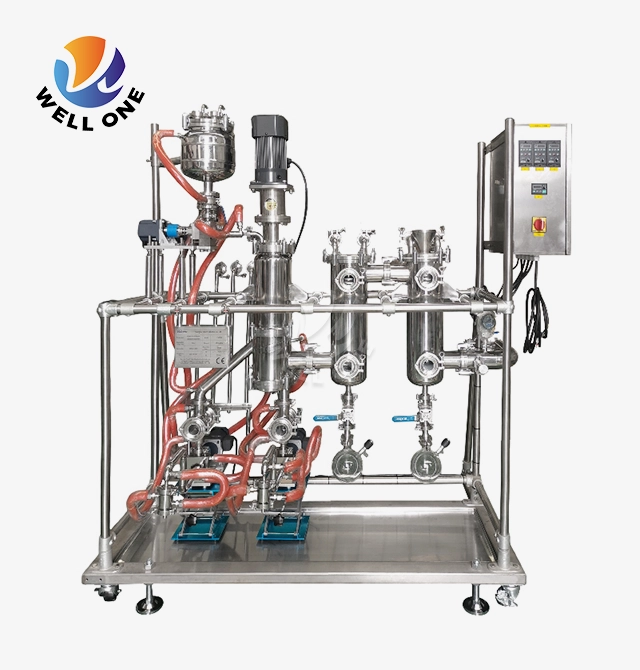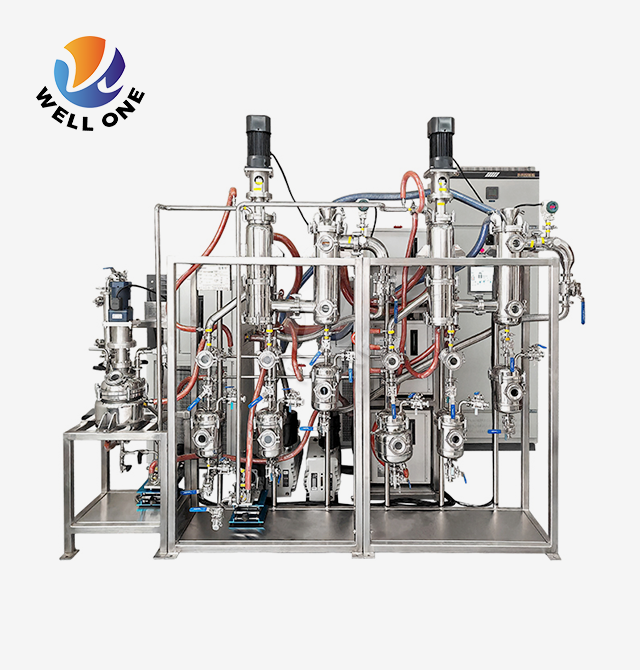What Type of Vacuum Pump is Suitable for a Short Path Distillation Setup?
Short path distillation is a specialized technique used for separating and purifying compounds with high boiling points or those that are thermally sensitive. In this process, the distillation path is significantly shortened, enabling efficient separation at lower temperatures and reduced thermal exposure. The use of the right vacuum pump is crucial for achieving optimal performance in a short path distillation setup, as it plays a vital role in creating and maintaining the necessary vacuum conditions. Selecting the appropriate vacuum pump requires careful consideration of various factors, including the desired vacuum levels, compatibility with the distillation process, and specific requirements of the system.
Overview of Short Path Distillation
Short path distillation is a specialized distillation technique that involves a significantly shortened path between the evaporation and condensation surfaces. Unlike conventional distillation methods, where the vapors travel a longer distance, the short path allows for more efficient separation of compounds with high boiling points or those prone to thermal degradation. This technique finds applications in various industries, such as pharmaceuticals, fine chemicals, and specialty materials, where the separation and purification of sensitive compounds are essential.
The role of vacuum pumps in short path distillation is crucial, as they create and maintain the necessary vacuum conditions for the distillation process to occur effectively. By reducing the pressure within the system, the boiling points of the compounds are lowered, allowing for distillation to occur at lower temperatures, thereby minimizing thermal degradation.
Importance of Vacuum Pump Selection
Choosing the right vacuum pump is a critical factor in ensuring the efficiency and success of a short path distillation setup. Different vacuum pump types have varying capabilities in terms of the vacuum levels they can achieve, flow rates, and compatibility with the distillation process. Selecting an inappropriate vacuum pump can lead to suboptimal performance, compromised product quality, or even system failure.
The quality of the final distilled product is heavily dependent on the vacuum pump's ability to create and maintain the required vacuum conditions throughout the distillation process. Inadequate vacuum levels or fluctuations can result in incomplete separation, reduced yield, or contamination of the distillate.
Rotary Vane Vacuum Pump
One of the most commonly used vacuum pumps in short path distillation setups is the rotary vane vacuum pump. These pumps are known for their robust construction and ability to handle a wide range of applications. They operate by using a rotating vane that sweeps against the pump's cylindrical walls, creating a vacuum as the volume between the vanes and the walls decreases.
Rotary vane vacuum pumps are well-suited for short path distillation systems as they can achieve the necessary vacuum levels required for most distillation processes. They are capable of attaining ultimate vacuum pressures in the range of 10^-3 to 10^-4 mbar, which is suitable for many short path distillation applications. Additionally, rotary vane pumps offer reliable performance and are relatively inexpensive compared to other vacuum pump types.
Diaphragm Vacuum Pump
For distillation processes that require a clean, oil-free vacuum environment, diaphragm vacuum pumps are an excellent choice. These pumps operate by using a flexible diaphragm that reciprocates back and forth, creating a vacuum on the suction side. Diaphragm pumps are inherently oil-free, making them suitable for applications where the presence of oil vapors or contamination is not desirable.
In short path distillation setups, diaphragm vacuum pumps offer several advantages. First, they eliminate the risk of oil contamination, ensuring the purity of the distilled product. Second, they generate minimal particulate matter, which is crucial for sensitive distillation processes. Additionally, diaphragm pumps are relatively quiet and vibration-free, making them suitable for operation in controlled environments.
Scroll Vacuum Pump
Scroll vacuum pumps are another oil-free option that can be employed in short path distillation systems. These pumps operate by using two spiral-shaped scroll plates that fit together and create a series of crescent-shaped pockets. As the scrolls rotate, these pockets progressively decrease in volume, compressing the gas and creating a vacuum.
Scroll vacuum pumps offer several advantages for short path distillation applications. They are intrinsically oil-free, eliminating the risk of product contamination. Additionally, they are known for their low maintenance requirements, as they have few moving parts and do not require frequent oil changes. Scroll pumps can achieve ultimate vacuum pressures in the range of 10^-3 to 10^-4 mbar, making them suitable for many short path distillation processes.
Diffusion Pump
In applications that require ultra-high vacuum levels, such as specialized short path distillation setups for highly volatile compounds or high-purity product requirements, diffusion pumps may be employed. Diffusion pumps are designed to achieve extremely low pressures, typically in the range of 10^-6 to 10^-9 mbar.
Diffusion pumps operate by using a high-speed jet of dense vapor, typically mercury or oil, to capture and direct gas molecules towards the pump's exhaust. These pumps require a backing pump, often a rotary vane or diaphragm pump, to maintain their operation. While diffusion pumps offer exceptional vacuum performance, they are more complex and expensive than other pump types, and may require additional safety considerations due to the use of hazardous materials.
Considerations for Vacuum Pump Selection
When selecting a vacuum pump for a short path distillation setup, several factors must be considered to ensure optimal performance and compatibility with the distillation process:
- Operating pressure: The vacuum pump must be capable of achieving and maintaining the desired vacuum levels required for the specific distillation process.
- Flow rate: The pump should have sufficient flow rate capacity to handle the gas load generated during the distillation process, ensuring efficient evacuation and maintaining the desired vacuum levels.
- Compatibility with the distillation process: The vacuum pump should be compatible with the compounds involved in the distillation, avoiding potential contamination or chemical reactions that could compromise the integrity of the system or the final product.
- System requirements: The vacuum pump should be compatible with the overall design and specifications of the short path distillation setup, including factors such as size, power requirements, and integration with other components.
- Operating temperature: Depending on the distillation conditions, the vacuum pump may need to be capable of operating within specific temperature ranges without compromising performance or reliability.
Maintenance and Care of Vacuum Pumps
Proper maintenance and care of vacuum pumps are essential for ensuring their longevity and optimal performance in short path distillation setups. Regular maintenance practices, such as checking and changing oil levels (for oil-sealed pumps), cleaning or replacing filters, and inspecting for wear or damage, can help prevent premature failure and downtime.
Troubleshooting and addressing issues promptly is crucial to maintain the efficiency of the vacuum pump and the overall distillation process. Common issues that may arise include leaks, decreased pumping speed, overheating, or excessive noise or vibration. Following the manufacturer's recommended maintenance schedules and procedures can help mitigate these problems and extend the lifespan of the vacuum pump.
Conclusion
Selecting the appropriate vacuum pump is a critical factor in the success and efficiency of a short path distillation setup. The vacuum pump plays a vital role in creating and maintaining the necessary vacuum conditions for the distillation process, directly impacting the quality and yield of the final product.
Different vacuum pump types, such as rotary vane, diaphragm, scroll, and diffusion pumps, offer varying capabilities and advantages suited for different short path distillation applications. Factors like operating pressure, flow rate, compatibility with the distillation process, and system requirements should be carefully considered when choosing a vacuum pump.
Proper maintenance and care of the vacuum pump are equally important to ensure its longevity and optimal performance, minimizing downtime and ensuring consistent and reliable operation throughout the distillation process.
By carefully selecting the appropriate vacuum pump and implementing proper maintenance practices, researchers and manufacturers can optimize their short path distillation setups, achieving efficient separation and purification of valuable compounds while minimizing thermal degradation and maximizing product quality.
Xi'an Well One Chemical Technology Co., Ltd is a professional Short Path Distillation Setup manufacturer, renowned for delivering the best quality products. We prioritize selecting the finest raw materials and employ state-of-the-art equipment along with a dedicated research team to ensure top-notch quality. The superior quality of our equipment has received widespread acclaim from our satisfied customers. Our professional team is always ready to assist you in finding the perfect product that suits your requirements. You can reach out to us via mobile at (+86) 18191320360 or email us at info@welloneupe.com. We look forward to serving you and meeting your needs.
References:
1. Shuchen, B., & Zimmermann, S. (2017). Short path distillation: A review of the fundamentals and applications in the purification of organic and inorganic materials. Chemical Engineering Science, 167, 126-143.
2. Hickman, C. P., & Gaugler, C. E. (2020). Vacuum Technology: Principles and Applications. Springer Nature.
3. Fremerey, J. K. (2014). Vacuum Pumps for Short Path Distillation. Chemical Engineering Progress, 110(7), 36-40.
4. Roth, A. (2012). Vacuum Technology. Elsevier Science.
5. Dushman, S., & Lafferty, J. M. (2012). Scientific Foundations of Vacuum Technique. John Wiley & Sons, Inc.
6. Becker, E., & Stratmann, F. (2001). The Molecular Distillation of High-Vacuum Pumps. Journal of Vacuum Science and Technology A, 19(1), 18-25.
7. Toh, J. (2017). A Guide to Vacuum Pumps for Distillation Processes. Chemical Engineering World, 52(5), 42-48.
8. Kohl, A. L., & Nielsen, R. B. (1997). Gas Purification. Gulf Professional Publishing.
9. Baykara, S. Z. (2018). Vacuum Distillation of Liquid Mixtures. Separation Processes in the Food and Biotechnology Industries: Principles and Applications, 213-239.
10. Peng, J., & Shuai, X. (2020). Vacuum Pump Selection and Maintenance for Short Path Distillation Systems. Journal of Chemical Engineering and Process Technology, 11(3), 397-403.







